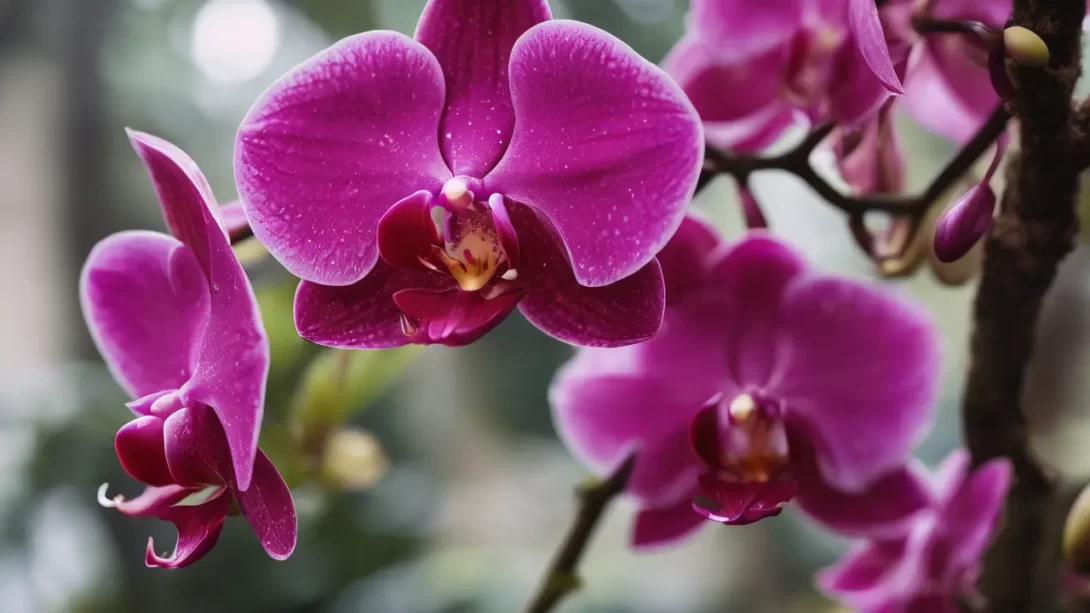Growing orchids on trees can transform your garden into a tropical paradise, emulating the natural environment where many orchid species thrive. Orchids attached to trees often exhibit more vigorous growth and spectacular blooms, as this method replicates their natural epiphytic state. Understanding why and how some orchids flourish better when mounted on trees is crucial for any enthusiast looking to adopt this beautiful and natural orchid-growing method.
Orchids and Their Natural Habitat
In their natural habitat, many orchid species are epiphytes, meaning they grow on other plants, usually trees, without deriving nutrients from their host. They absorb moisture and nutrients from the air and rain, with their roots exposed to the environment. This growth habit allows for excellent drainage and access to light, which are critical for their health. Mimicking these conditions as closely as possible in a garden setting can lead to healthier, more vibrant orchids.
Choosing the Right Orchid and Tree
Not all orchids or trees are suitable for this method. When selecting an orchid for tree mounting, choose species known for being epiphytic, such as Phalaenopsis, Dendrobium, or Oncidium. These orchids are more likely to adapt to growing on a tree.
The choice of tree is equally important. The tree should have rough bark to help the orchid’s roots anchor securely. It should also be healthy and stable. Good options include oak, elm, or maple trees. Avoid trees with smooth bark or those that shed their bark easily, like some types of eucalyptus.
Materials Needed
To successfully attach an orchid to a tree, you will need a few key materials:
- A healthy orchid plant, preferably an epiphytic species.
- Ties or fishing line to secure the orchid to the tree.
- Sphagnum moss or another water-retaining material to support moisture retention.
- A sterile, sharp knife or scissors for any necessary trimming.
Step-by-Step Guide to Attaching an Orchid to a Tree
Preparation
Start by preparing the orchid. If the plant has any dead or rotting roots, use a sterile knife or scissors to trim them away. This helps the orchid focus its energy on healthy growth. Next, clean the chosen area on the tree bark where you plan to attach the orchid. The spot should be free of moss, lichen, or any other growth and should offer the orchid adequate light and protection from extreme weather conditions.
Mounting the Orchid
Once you have prepared both the orchid and the tree, it’s time to mount the orchid. Follow these steps:
- Position the Orchid: Hold the orchid against the tree in the chosen spot. The ideal position should allow the orchid to receive sufficient but not excessive sunlight. Morning light is generally preferable, with some shade in the afternoon.
- Secure the Orchid: Use ties or fishing line to attach the orchid to the tree. Be careful not to damage the orchid’s roots or leaves. The ties should be firm enough to hold the orchid in place but not so tight as to strangle or cut into the plant as it grows.
- Check Stability: After securing the orchid, gently test it to ensure it is stable and won’t move too much in the wind. A stable positioning is crucial for the orchid to establish its new growth onto the tree.
Adding Moss and Water-Retaining Materials
To help your orchid stay hydrated, especially in the initial stages of attachment, you’ll need to add moss or a similar water-retaining material.
- Apply Sphagnum Moss: Surround the orchid’s roots with sphagnum moss. This moss will hold moisture around the roots, mimicking the humid environment orchids are accustomed to in the wild.
- Secure the Moss: Use additional ties to secure the moss around the orchid. Ensure that the moss is in contact with the roots but not covering the orchid’s crown or growing points.
- Ensure Good Air Circulation: While the moss should be snug against the roots, be sure there is still good air circulation. Overly tight moss can lead to rot and other health issues for the orchid.
Aftercare and Maintenance
After mounting the orchid, proper aftercare is essential for the plant to thrive.
Watering Regimen
- Frequent Watering: Initially, your tree-mounted orchid will require more frequent watering than it did in a pot. This is especially true in dry or windy conditions. Water the orchid by misting or gently pouring water over the roots and moss.
- Adjusting Watering Frequency: Over time, as the orchid begins to attach its roots to the tree, you can gradually reduce the frequency of watering. The orchid will start to absorb moisture from the environment, requiring less supplemental watering.
- Monitoring Moisture Levels: Regularly check the moisture level of the moss and the condition of the orchid’s roots. This will guide you in adjusting your watering schedule to meet the plant’s needs.
Monitoring for Pests and Diseases
Regularly inspect your orchid for signs of pests or diseases. Common issues include scale insects, aphids, and fungal infections. Early detection is key to successful treatment. If you notice any signs of distress, such as discolored leaves or a sticky residue (a sign of aphid infestation), address the problem immediately using appropriate organic or chemical treatments.
Seasonal Care Tips and Fertilization
Orchids mounted on trees will still benefit from periodic fertilization. Use a balanced, water-soluble fertilizer at a reduced strength every few weeks during the growing season. In colder months, reduce or stop fertilizing as the orchid’s growth slows down. Also, be mindful of changing weather conditions. In areas with harsh winters, additional protection might be necessary to shield the orchid from extreme cold.
Troubleshooting Common Issues
If the orchid seems to be struggling, consider the following factors:
- Poor Attachment: If the orchid doesn’t seem to be attaching to the tree, ensure that it’s stable and not moving too much. You may need to re-secure it with additional ties.
- Insufficient Growth or Flowering: This might be due to inadequate light, water, or nutrients. Assess the orchid’s location and care regimen and adjust as needed.
- Signs of Disease or Pests: If you notice signs of disease or pests, isolate the issue and treat it promptly to prevent spread.
Conclusion
Attaching an orchid to a tree can be a rewarding endeavor, bringing a natural and exotic feel to your garden. By carefully selecting the right orchid and tree, properly mounting the plant, and providing ongoing care, you can successfully encourage your orchid to thrive in its new environment. Remember, patience is key; it takes time for orchids to adjust and establish themselves on a tree. With attention and care, you’ll be rewarded with a stunning display that celebrates the unique beauty and adaptability of orchids.



